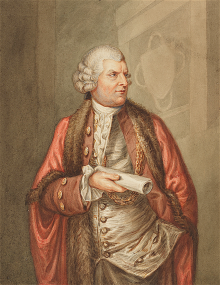
Robert Taylor [also known as Sir Robert Taylor] was born in Woodford, Essex, England in 1714. His father, also known as Robert Taylor (?-1742), was a master mason and monumental sculptor. Robert Taylor, junior was apprenticed to the sculptor Henry Cheere (1703-1781) in 1732. In 1741, following the completion of his apprenticeship, he travelled to Rome to continue his studies, however, in 1742 his father died and he was required to return home. He discovered that his father was bankrupt. Despite this, with the help of family friends, he was able set up in business as a sculptor, and within two years, by dint of hard work, was commissioned by Parliament to create and erect a monument to Captain Corrnewall in Westminster Abbey. On 4 August 1744 Taylor was admitted to the freedom of the Mason's Company and that year was also commissioned to carve the pediment of the Mansion House in London.
It is unclear when Taylor switched to architecture. His first significant work was a house he designed for himself at 66 Charing Cross, London in 1745 and interiors at 14 St James's Square (1748–50) for Peter du Cane. Within a decade he was well established in the profession. His clients came from the newly emerging prosperous middle classes, including bankers, company directors, merchants, traders and commissioned officers in the army and navy, for whom he would design large country and town houses. It has been calculated that he designed over 50 country houses alone. He also designed or made alterations to some 15 public buildings, including extensive additions to the Bank of England (1766-88) and a number of bridges. In 1755 he designed a mausoleum for Robert Colebrooke at Chilham Church, Kent.
So successful was Taylor's architectural practice that when he died in 1788 he left an estate of £180,000. In comparison, Christopher Wren estate was valued at £50,000. He died in London on 27 September 1788.
For a detailed list of architectural projects by Taylor see:
Colvin, pp. 1024-1028; see also British Listed Buildings
Binney, Marcus. Sir Robert Taylor : from rococo to neoclassicism. London: Allen & Unwin, 1984.
Binney, Marcus. ‘Apotheosis of the rococo: the Lord Mayor's coach’ [designed in 1757 by the architect Sir Robert Taylor. Country Life vol. 164, no. 4245, 16 November 1978 pp. 1596-1598
Binney, Marcus. ‘Sir Robert Taylor's additions to the Bank of England’. Country Life 20 November 1969 pp. 1326-1330
Binney, Marcus. ‘Sir Robert Taylor's additions to the Bank of England’. Country Life 13 November 1969 pp. 1244-1248
Binney, Marcus. ‘Sir Robert Taylor's Grafton Street’. [Town houses in Grafton Street, Mayfair, London, built by Sir Robert Taylor between 1768 and 1775] Country Life vol. 170, no. 4396, 19 November 1981 pp. 1766-1769.
Binney, Marcus. ‘Sir Robert Taylor's Grafton Street’. [Town houses in Grafton Street, Mayfair, London, built by Sir Robert Taylor between 1768 and 1775] Country Life vol. 170, no. 4395, 12 November 1981 pp. 1634-1637.
Binney, Marcus. ‘The villas of Sir Robert Taylor (1714-1788)’. Country Life vol. 142, no. 3671, 13 July 1967 pp. 78-82
Binney, Marcus. ‘The villas of Sir Robert Taylor (1714-1788)’. Country Life vol. 142, no. 3670, 6 July 1967 pp. 17-21
Colvin, Howard, A Biographical Dictionary of British Architects 1600-1840. New Haven, Connecticut and London: Yale University Press, 4th edition, 2008
Esdaile, K. A. ‘Sir Robert Taylor as sculptor’. Architectural Review February 1948 pp. 63-66
Gomme, Andor. ‘The architect of Barlaston Hall, Staffordshire. [Sir Robert Taylor] Country Life vol. 143, no. 3711, 18 April 1968 pp. 975-979.
Hussey, Christopher. ‘Asgill house, Richmond’ [Designer: Sir Robert Taylor]. Country Life 9 June 1944 pp. 992-995
Service, Alastair. The Architects of London and their buildings from 1066 to the present. London: The Architectural Press, 1979
‘Town houses. II, Ely House, Dover Street W’ [Architect: Robert Taylor]. Architectural Review vol. 27, February 1910 pp. 105-109.